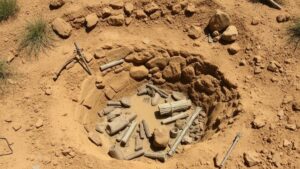Mechanical Traps in Ancient Treasure Vaults: Gears, Levers, and Counterweights
Mechanical Traps in Ancient Treasure Vaults: Gears, Levers, and Counterweights
Throughout history, the allure of hidden treasures has driven civilizations to create elaborate vaults and chambers to protect their riches. These enclosures often included advanced mechanical traps designed to deter thieves and protect valuable artifacts. Using principles of physics and mechanics, ancient cultures ingeniously engineered systems involving gears, levers, and counterweights. This article explores the mechanisms behind these traps, supported by historical examples and relevant technologies.
The Historical Context of Mechanical Traps
Mechanical traps have roots in several ancient civilizations, including those of Egypt, Rome, and China. The primary purpose of these traps was to safeguard treasures from potential robbers who sought to exploit the wealth and resources of these societies. For example, the burial chambers of the Egyptian pharaohs, notably the tomb of Tutankhamun, were designed with complex traps to prevent grave robbers from accessing the treasures within.
An insightful example is the use of tunnel systems in ancient Chinese tombs, such as that of the first emperor Qin Shi Huang. e tunnels contained numerous traps that could activate if intruders ventured too far from the intended path. Evidence shows that those in charge of these tombs utilized knowledge of mechanics to amplify their defenses.
Understanding Gears in Mechanical Traps
Gears, a critical component in many mechanical traps, create motion and facilitate interaction between different elements of a system. The principle of gear ratios enables a small input to result in significant output force when configured correctly. In the context of treasure vaults, gears were often part of a locking mechanism or a trapdoor system.
One historical example can be found in the ancient Greek engineer Hero of Alexandrias writings, where he described water-based mechanisms that employed gears to operate doors and levers. Useing such technologies, vaults could be crafted to only unlock under specific conditions, such as the placement of an object in the correct location or the solution to a riddle.
- The use of differential gears allowed for intricate locking mechanisms that made unauthorized access challenging.
- Cataloged cases reveal that the use of interacting gears could create false exits or activate traps when an intruder attempted to enter the wrong pathway.
The Role of Levers in Traps
Levers function as force multipliers, allowing a small effort to lift or move heavy loads. In ancient treasure vaults, levers played a vital role in creating traps that could be set to activate based on the weight or position of an intruder. This is evident in the design of spring-loaded mechanisms that used levers to trigger a trapdoor or release a series of projectiles.
One noteworthy example includes the traps found in the tomb of the ancient Egyptian pharaoh Seti I. A lever mechanism was designed to release heavy stones, effectively sealing the entrance if any unauthorized individuals entered. Historical records suggest that such mechanisms resulted in severe consequences for many tomb robbers, thereby enhancing the mythology surrounding these graves.
- The proximity of the lever to threshold areas made it difficult to bypass without triggering the trap.
- Lever systems could be coupled with sensory mechanisms, allowing for intelligent activation based on the actions of the intruder.
Counterweights: The Balance of Power
Counterweights utilize gravitational force to create balance within mechanical systems. In the context of treasure vaults, counterweights ensured the reliability and precision of traps. They acted as a fail-safe mechanism, where the release or alteration of weight would trigger a series of actions designed to secure the vault.
A striking application of counterweights can be seen in the design of a classic vault door. Historical illustrations depict large stone doors that would only swing open when a corresponding weight was alleviated on the opposite side. This intricate design minimized the risk of unauthorized access as the counterweight would automatically return the door to a closed position once pressure was removed.
- Some vaults employed intricate designs where counterweights would be displaced by secret pathways, implementing a clever security measure against intruders.
- Research indicates that applications of counterweights drastically improved the efficiency of mechanical traps, allowing for rapid engagement and re-engagement.
The Impact of Mechanical Traps on Modern Security
The study of ancient mechanical traps not only illuminates historical perspectives on security but can also inform contemporary systems. Modern security technology often adopts similar mechanical principles in combination with electronic systems, ensuring that access control remains robust. While advanced technology has supplanted many methods, the fundamental concepts of using gears, levers, and counterweights can still be observed.
For example, modern safe designs incorporate weighted locking mechanisms that operate similarly to those found in ancient vaults. Also, the principles of mechanical traps are embedded in high-security facilities where physical barriers must withstand unauthorized entry.
Actionable Takeaways
- Understanding the mechanics behind ancient traps can influence modern security designs.
- Useing principles of gear ratios, lever action, and counterbalancing can enhance the effectiveness of new technologies.
- Continued study of historical examples can inspire innovative security solutions that are both practical and secure.
As societies evolve, the lessons learned from the craftsmanship of ancient engineers should not be forgotten, establishing a legacy of security that transcends time.


